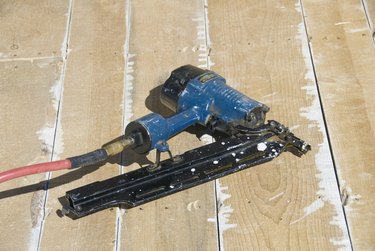
Nail guns reduce time and labor, replacing the old "swing-a-hammer" technique with automated nailing. You may use certain types of nail guns to install a hardwood floor, but practice on scrap wood first to ensure that you master the correct technique. You can use three types of nailers on a hardwood floor: a flooring nailer, a finish nailer or a flooring and mallet nailer. Framing nail guns are not suitable due to nail size and configuration.
The Nailing Process
Video of the Day
Hardwood planks fit end to end and side to side with a tongue-and-groove assembly. After you install the first plank in the corner of a room, every subsequent plank will fit tightly together to form a smooth floor. The groove edge of the plank faces the wall, and the tongue side faces outward; this is the part where you will insert the nails. The nails you use should have little or no heads so that they will sink slightly beneath the surface of the wood and will not impede a tight fit when you install the next row of planks. For the first course of planks, a hammer and nail set may be needed for face-nailing.
Video of the Day
Flooring Nailer
One of the best nailers to use to install a hardwood floor is a pneumatic flooring nailer or stapler. Made specifically to fit over the top edge of the plank and the tongue, this nailer shoots a headless nail through the tongue and into the subfloor or the floor joist beneath. When positioned correctly, making a mistake with this nailer is difficult.
Finish Nailer
Not everyone keeps a flooring nailer around because it has only one use. If you're handy with a finish nail gun, you can use it to install a hardwood floor. A finish nail gun, designed for trim work, shoots a near-headless nail that does not mar the surface look of the wood, which makes a finish nailer effective for installing hardwood floors as well. To use this nailer, position the nail shoe on the wood tongue at about a 15-degree angle downward and inward, toward the plank. Depress the nail shoe while holding the nailer carefully in place, and pull the trigger. Use finish nails that are long enough to go through the subfloor, if there is one, and at least 1/2 inch into the floor joists.
Flooring and Mallet Nailer
Until power nailers became common in the flooring industry, a manual flooring nailer and a mallet were standard, and it still does a good job today. Like the pneumatic flooring nailer, the manual nailer holds flooring nails and features a shaped nail shoe that fits right over the edge of the plank and the tongue. After positioning the nailer, tap on the nailing cap with the mallet to shoot a flooring nail, staple or cleat through the tongue. Flooring and mallet nailers may use gravity and a spring-loaded system to drive the nails, or they may employ compressed air to shoot the nails when you hit the nailing cap with the mallet.